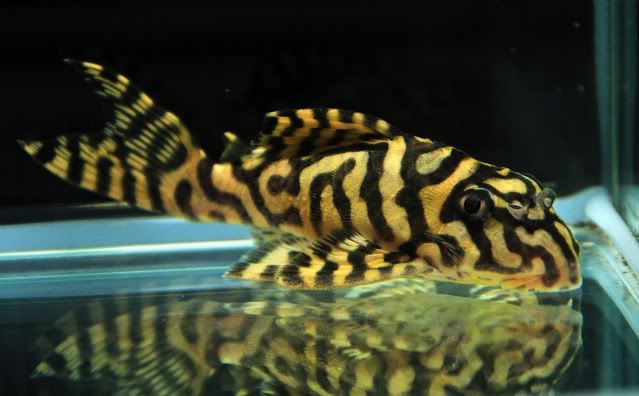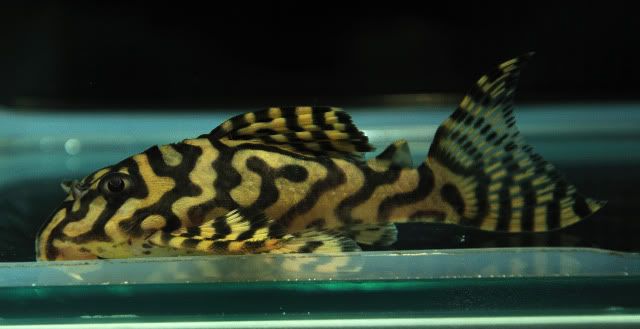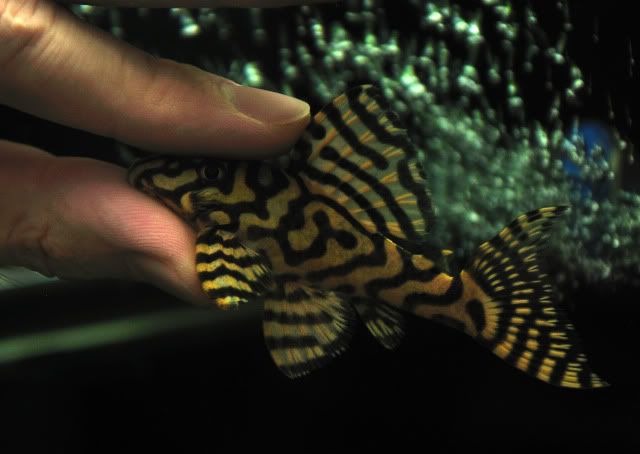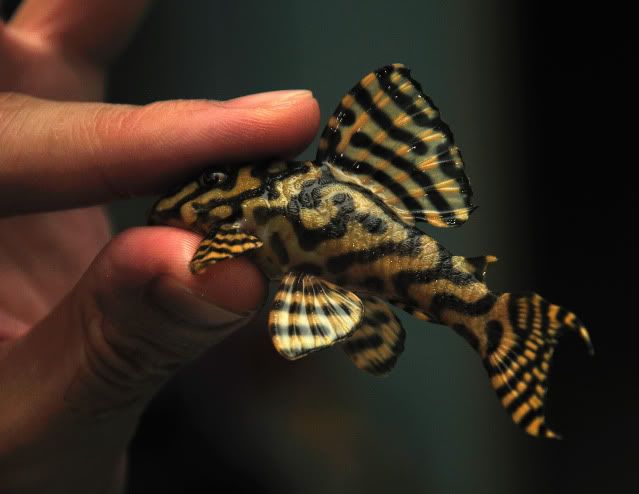Page 1 of 2
A very nice yellow based Hypancistrus sp.
Posted: 06 Sep 2011, 02:22
by johannes
Re: A very nice yellow based Hypancistrus sp.
Posted: 06 Sep 2011, 02:38
by corybrummie2010
Wow! thats one stunning fish

Re: A very nice yellow based Hypancistrus sp.
Posted: 06 Sep 2011, 06:12
by mds
Very nice fish,Johannes

Re: A very nice yellow based Hypancistrus sp.
Posted: 06 Sep 2011, 09:29
by Neo
Very nice fish indeed

Re: A very nice yellow based Hypancistrus sp.
Posted: 06 Sep 2011, 14:47
by Unungy
Nice fish.
It looks like a male to me.
Saul
Re: A very nice yellow based Hypancistrus sp.
Posted: 08 Sep 2011, 01:45
by johannes
Thanks all for the nice comments, btw it's a female bro unungy...
Anyone can shed some light on the id?
Re: A very nice yellow based Hypancistrus sp.
Posted: 08 Sep 2011, 05:31
by stuby
Re: A very nice yellow based Hypancistrus sp.
Posted: 09 Sep 2011, 05:21
by johannes
that looks different bro Stuby..

Re: A very nice yellow based Hypancistrus sp.
Posted: 09 Sep 2011, 05:37
by notaclue
Not a clue but thank you for sharing beautiful pictures of a stunning pleco.
Re: A very nice yellow based Hypancistrus sp.
Posted: 09 Sep 2011, 05:51
by AleGer
Beautiful fish:)
Re: A very nice yellow based Hypancistrus sp.
Posted: 09 Sep 2011, 09:18
by Bubbles2112
As it has already been said....I just gotta add my thought! I have no idea what specifically your pleco is-- but it sure is beautiful! You photos are also very good

Re: A very nice yellow based Hypancistrus sp.
Posted: 10 Sep 2011, 10:48
by Jools
How do you know it's a
?
Jools
Re: A very nice yellow based Hypancistrus sp.
Posted: 10 Sep 2011, 12:49
by jac
I didn't dare say anything before but I agree with Jools.
Thinking it could be Peckoltia...??
Re: A very nice yellow based Hypancistrus sp.
Posted: 12 Sep 2011, 08:51
by johannes
Jools wrote:How do you know it's a
?
Jools
It is definitely a Hypancistrus, the dentition, mouth shape, head shape and body shape, etc. Definitely not a Peckoltia and others..
Re: A very nice yellow based Hypancistrus sp.
Posted: 12 Sep 2011, 12:23
by plecoboy
There was a Tiawan retailer that posted pics of a similar fish. I kept the pics, but I can't remember their name. I know they have a Facebook page.
Re: A very nice yellow based Hypancistrus sp.
Posted: 15 Sep 2011, 17:46
by HaakonH
Might well be L236 methinks ;) L236 is said to exist among L333 near Porto Do Moz, according to Janne Ekström who tends to know what he's talking about. And Janne's pic of L236 certainly shows a similar fish with the same cream-yellow hue.
Haakon
Re: A very nice yellow based Hypancistrus sp.
Posted: 16 Sep 2011, 10:41
by johannes
Hi Mr HaakonH,
thanks for the insight, didnt know that L333 may/do exist with L236, however, the body shape does not conform to L236 longish body shape, only the pattern does...
that is the interesting issue here...

johannes
Re: A very nice yellow based Hypancistrus sp.
Posted: 16 Sep 2011, 14:16
by Janne
Have a look on the original picture of L236 and you will see that the body shape is not elongated, slim or longish in this species. Most pictures showed as L236 is not this species, they belong to the L173-L399-L400 and lower xingu group of Hypancistrus, but your´s are close enough to be the real L236 that have a stubbish body, base colour from whitish to yellow.
Janne
Re: A very nice yellow based Hypancistrus sp.
Posted: 16 Sep 2011, 22:29
by pleco22
Hi,
it is a nice Hypancistrus, but in my opinion it has nothing to do with L 236. Body shape is L 333, coloration and pattern could be an aberration. The original picture of L 236 published in the DATZ in Germany shows a flat an elongated Hypancistrus (more L 66/400) type.
http://www.datz.de/Artikel.dll/l-235-bi ... 9EF5A36E84
In my opinion this picture shows the only "original" L 236. That does not mean, that every L 236 looks like this, but the body shape is typical and different from other variants.
But it is also true, that many L 236 in the market are just very nice fish with a white based pattern.. . . but this is another never ending story.
@ johannes: please give some reasons for your statement about Hypancistrus sp. l333 sim 236.
Re: A very nice yellow based Hypancistrus sp.
Posted: 16 Sep 2011, 23:59
by Janne
The picture in the link to Datz also show an L236 ;) taken from a little different angle, L236 is not a flat and elongated species... it's much more similar to L333 than it's to L66.
Janne
Re: A very nice yellow based Hypancistrus sp.
Posted: 17 Sep 2011, 05:55
by pleco22
Hi,
@Janne: changing the proportions or body shape of a fish ist only possible in one direction (for optical reasons):
- long to short
- flat to fat
but not the way around! (only with massiv work in photoshop).
This is another angle from the same fish, from the same photographer:
http://www.l-welse.com/gallery/displayi ... mageid=301
This picture shows an elongated and flat fish, too. This picture is the "holotype" for L 236. We know, that the body shape is relevant to distinguish different variants of hypancistrus, and the pattern or coloration ist mostly not.
In my opinion, this kind of coloration, and this is empirical observable if you breed l 400, l66 l 333 and so in large numbers - is an aberration, with occurs rarely. Its like a negative effect, that the dark lines change into white and the body color ist dark. This effect occurs sometimes.
This picture shows the effect:

Making L 236 with photoshop


this is L 287

This is a normal colored l 400

Wow! You could sell this as L 236.

This is a variant, wich I call "last emperor"

And you see. Photoshop could make an normal pattern out of a real beauty.
Please note, this pictures should only show an effect, wich occurs very rare. But if you just try this with other pictures, you will be surprised.
I know that nature uses no photoshop, but I was very surprised. Is L 236 just an error in pigmentation?
regards
Re: A very nice yellow based Hypancistrus sp.
Posted: 17 Sep 2011, 12:10
by HaakonH
Personally I belive that L236, the original, is just that - an unusually pigmented individual of a species which is usually more dark than light. I also think that's the case with the fish this thread is about. I think that L236 is a label for a colorvariety of a species we already have other number(s) for. When I bred L236 from Glaser, most of the offspring were dark with thinner light bands, but a few individuals turned out the other way around. I will however not claim that I bred the exact same species as the original L236 is ;) I just think this goes for most dark/light Hypancistrus, some individuals will stand out as different to the norm.
I couldn't help myself, I had to test out the idea presented by Pleco22 so here's an example of one of my L236 from Glaser. Photo courtesey of my friend Erlend:
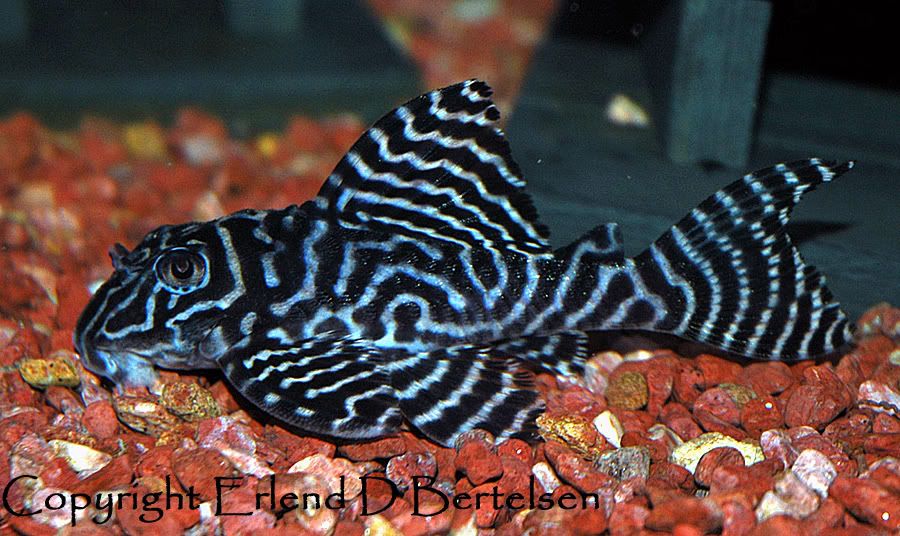
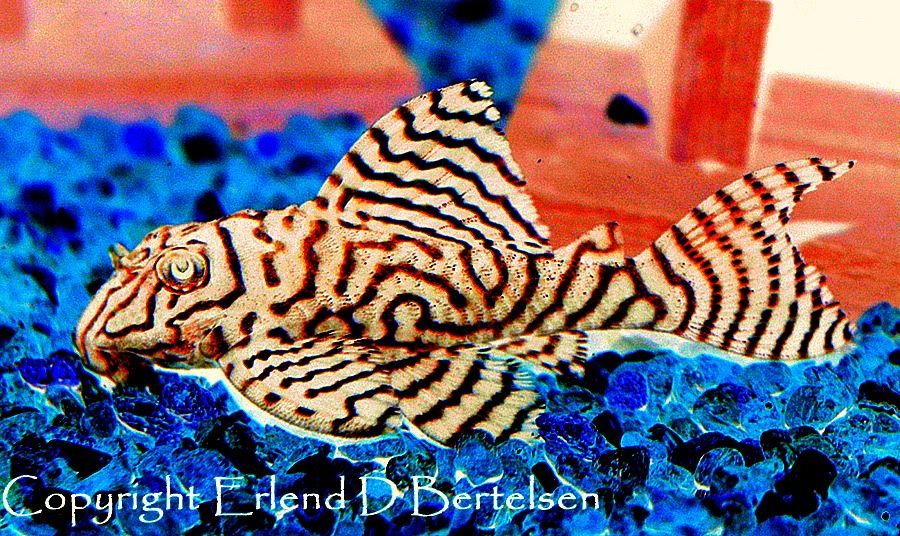
Haakon
Re: A very nice yellow based Hypancistrus sp.
Posted: 17 Sep 2011, 13:20
by Janne
The second link shows a stubby species and not elongated even if it looks like a flatter/thinner species in these pictures, have a look on the shape of the head, it's a little thin over the body in these pictures but it will be fatter and stubbier after some meals.
L287 don't exist as a separate species, this variant belongs to the same group as L173 does and are collected at the same locations and not in Rio do Pará that first was stated.
You don't need to use photoshop to sell another species as something else, it happens every day anyway, just look how many people that think they have L236 in their aquariums. You have your opinion and I have mine and I will not change my opinion. I do respect that you have a different opinion then me and that is good, if everyone agreed in everything the progress would stop.
Janne
Re: A very nice yellow based Hypancistrus sp.
Posted: 17 Sep 2011, 19:50
by pleco22
Hi,
if you use my photoshop-trick with the original picture from the DATZ (I won't post it because of copyright reasons) you will get a pattern that many of the "real" L 236 have in Germany.
I have heard, that some snakes shows this kind of negative-pattern effect as an aberration.
@ Janne. Don't get me wrong - I have no opinion when it comes to L 236, only questions an some assumptions. And the main question is. Are these totally deviant markings a sign for a species, or for an aberration? What do you think.
Re: A very nice yellow based Hypancistrus sp.
Posted: 17 Sep 2011, 20:04
by Janne
pleco22 wrote:Are these totally deviant markings a sign for a species, or for an aberration? What do you think.
Aberration, like it's for several other L-numbers of Hypancistrus from Xingu. But L236 is more related to L333 then it's to L66 which are the 2 main species in this complex of "species", these 2 species are the most common species in Xingu with a wide spread distribution over a large area. These L-number I consider as different "species" from Xingu, L46, L66, L174, L333.
Then there are a group of Hypancistrus with very high variation that not are many different species, maybe 2 species, L173-L287-L345-L399-L400 but they are not the same species of one of the 4 first I mentioned, all these have a small distribution in a small area of Xingu where we find them all together at the same localities.
There are also a mimicry species of Hypancistrus living together with L174 which have the smallest known locality in Xingu.
Then it's the mysterious L250, I have to find one first or several would be better to have any opinions about this species, the pictures I have seen it remainds a lot of H. zebra but I need to see it alive.
Janne
Re: A very nice yellow based Hypancistrus sp.
Posted: 18 Sep 2011, 17:56
by johannes
Hey guys, thanks for the insightful discussion, from my humble experience and insight, i think the very nice patterning, such as in L236 shown in Datz and "last emperor" could be an abberation in pigmentation/pattern in which only occur in very small percentage, be it in the wild or captive bred..
@pleco22, hi bro what do you mean by "@ johannes: please give some reasons for your statement about Hypancistrus sp. l333 sim 236." Sorry i didn't really get you..

By the way, since there are many opposing ideas on the ID, can i ask which L-no. should i pair it to breed with?
Thanks..
Johannes
Re: A very nice yellow based Hypancistrus sp.
Posted: 18 Sep 2011, 21:26
by pleco22
Hi,
@Janne
This is very close to what I think about the situation of Xingu-Hypancistrus. In my opinion, L 236, L 173, L 287, L 345, L 399/400 and many other Hypancistrus without L-Numbers (all the Belo Monte stuff) are different kinds of transition forms between the common "species" like L 46, L 66, L 333, L 174 usw.
Problem is that a new kind of "transition" is taking place in our fish tanks. And that is hybridisation. In my opinion we have to find a solution, to avoid hybrids.
This nice fish, wich has started this discussion is a very special fish, no doubt. But it is a single fish, selected and separated from L 333. What will happen, if the keeper won't find a compatible female?
Regards
Re: A very nice yellow based Hypancistrus sp.
Posted: 19 Sep 2011, 03:43
by johannes
@Pleco22, so if you think this is L333, should i pair it with L333 (yellow) as well? If it is just an abberation of pattern.
*Thanks for the PM, i have edited my post.

To others who think otherwise, any confirmation on ID?
thanks also..
I really appreciate it.

Re: A very nice yellow based Hypancistrus sp.
Posted: 19 Sep 2011, 21:05
by pleco22
Hi,
First - I wish, that you will find a female with the same marking and body shape. And I keep my fingers cross. The yellow color could disappear. So search the internet and ask your local dealer.
But even if you find a fitting female the danger of unwanted hybridisation will be high.
Regards
Re: A very nice yellow based Hypancistrus sp.
Posted: 20 Sep 2011, 01:28
by Janne
pleco22 wrote:This is very close to what I think about the situation of Xingu-Hypancistrus. In my opinion, L 236, L 173, L 287, L 345, L 399/400 and many other Hypancistrus without L-Numbers (all the Belo Monte stuff) are different kinds of transition forms between the common "species" like L 46, L 66, L 333, L 174 usw. Problem is that a new kind of "transition" is taking place in our fish tanks. And that is hybridisation. In my opinion we have to find a solution, to avoid hybrids.
I think that hybridization is one part of the problem already in nature within this group of Hypancistrus from lower Xingu, that is why we find this huge variety and cannot define them as separate species. I'm still convinced that lower Xingu is a hotspot for this genus and some other genus of plecos showing a very large variety. it's not normal to find such a large diversity within the same genus in one river, you maybe find a large variety of 1 species but not many species in 1 genus in such small area. Compare with for example Panaque nigrolineatus, 1 variety per river all over the tropic south america... now they will become separate species, the same will happen with Hemiancistrus sabaji in the future and they will probably change the genus for these species, there are many look alike but from different rivers spread over south america, just think what a huge problem it will be to separate all look alike tetras

Some is of course the same species but there are many enough to work with that will show to be separate species, the work with south american fishes will never end if they not get extinct in the nature due all the damming projects.
I forgot, just because hybridization may occur in nature I don't support this in aquarium environment, instead it increase our responsibility to avoid hybridization. We don't need to make the problem more complex than it's... it's enought that mother nature is complex making it difficult for us human beings that are trying to understand the nature (which we probably never will do anyway to full).
Janne
